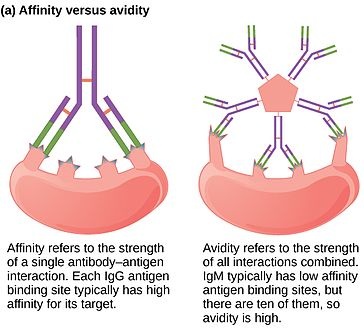Difference Between Affinity and Avidity
Key Difference – Affinity vs Avidity
Antibody antigen interaction is a crucial interaction in cells to react against infections. Antigens are the foreign particles that enter the host cells. They are mainly composed of polysaccharides or glycoproteins and have particular shapes. The interaction between antigen and antibody occurs according to the correct binding of the two parties by the non-covalent bonds such as hydrogen bonds, van der Waals bonds, etc. This interaction is reversible. Affinity and avidity are two parameters which measure the strength of the antigen-antibody interaction in immunology. The key difference between affinity and avidity is that affinity is the measure of the strength of individual interaction between an epitope and one binding site of the antibody whereas avidity is the measure of the overall bindings between antigenic determinants and antigen binding sites of the multivalent antibody. Affinity is one factor which influences the avidity of the antigen antibody interaction.
CONTENTS
1. Overview and Key Difference
2. What is Affinity
3. What is Avidity
4. Side by Side Comparison – Affinity vs Avidity
5. Summary
What is Affinity?
The affinity is a measure of the interaction between an antigen binding site of the antibody and an epitope of the antigen. Affinity value reflects the net result of the attractive and repulsive forces between individual epitope and individual binding site. High affinity value is a result of a strong interaction with more attractive forces between the epitope and Ab binding site. Low affinity value indicates the low balance between attractive and repulsive forces.
The affinity of monoclonal antibodies can be easily measured since they have a single epitope and are homogeneous. Polyclonal antibodies rate an average affinity value due to their heterogeneous nature and their differences in the affinities towards the different antigenic epitopes.
Enzyme-linked immunosorbent assay (ELISA) is a new technique in pharmacology which is used to measure the affinity of the antibodies. It results in more precise, convenient and informative data for affinity determination. High affinity antibodies bind with epitope quickly and make a strong bond which persists during the immunological assays while low affinity antibodies dissolve the interaction and are not detected by the assays.
What is Avidity?
The avidity of an antibody is a measure of the overall strength of the binding between the antigens and antibody. It depends on several factors such as affinity of the antibody towards the antigen, valence of antigen and antibody and the structural arrangement of the interaction. If the antibody and antigen are multivalent and have a favorable structural arrangement, the interaction remains very strong due to high avidity. Avidity always shows a high value than the summation of the individual affinities.
Most antigens are multimeric and most antibodies are multivalence. Hence, most antigen antibody interactions remain strong and stable due to high avidity of the antigen-antibody complex.

Figure01: Affinity and Avidity of an antibody
What is the difference between Affinity and Avidity?
Affinity vs Avidity | |
| Affinity refers to the strength of the interaction between one antigenic epitope with one antigen binding site of the antibody. | Avidity is the measure of the overall strength of the interaction between antigenic epitopes with multivalence antibody. |
| Occurence | |
| This occurs between individual epitope and individual binding site | This occurs between multivalent antigens and antibodies. |
| Value | |
| Affinity is the balance of attractive and repulsive forces. | Avidity can considered as a value more than the sum of the individual affinities. |
Summary – Affinity vs Avidity
Antigen antibody interaction is a specific, reversible, non-covalent interaction important in immunological studies. It is similar to the enzyme substrate interaction. Specific antigen binds with a specific antibody. Affinity and avidity are two measures of this interaction. Affinity reflects the strength of one interaction between an epitope and an antigen binding site of the antibody. Avidity reflects the overall strength of the antigen antibody complex. This is the difference between affinity and avidity. Avidity is a result of multiple affinities that occur in one antigen antibody complex since most antigens and antibodies are multivalent and maintain several interactions to stabilize the binding.
References:
1. Rudnick, Stephen I., and Gregory P. Adams. “Affinity and Avidity in Antibody-Based Tumor Targeting.” Cancer Biotherapy & Radiopharmaceuticals. Mary Ann Liebert, Inc., Apr. 2009. Web. 21 Mar. 2017
2. Sennhauser, F. H., R. A. Macdonald, D. M. Roberton, and C. S. Hosking. “Comparison of concentration and avidity of specific antibodies to E. coli in breast milk and serum.” Immunology. U.S. National Library of Medicine, Mar. 1989. Web. 22 Mar. 2017
Image Courtesy:
1. “Figure 42 03 04” By CNX OpenStax – (CC BY 4.0) via Commons Wikimedia
ncG1vNJzZmivp6x7pbXFn5yrnZ6YsqOx07CcnqZemLyue8OinZ%2Bdopq7pLGMm5ytr5Wau26txZ%2Bgp6GkrnqiusNmraxlkau2pbXTsmY%3D